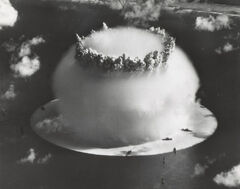
First atomic bomb test, 30 June 1962.
The War Without War is the period of international rivalry following the end of the Global War. It is characterized by a permanent state of hostility and a de jure (though not de facto) state of war among the wartime enemies. Since the detonation of an atomic bomb by Kramer Associates in the summer of 1962, the War Without War has also seen an atomic arms race among the world's major powers.
First Phase[]
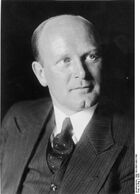
German Chancellor Heinrich von Richter.
Sobel refers to the War Without War going through three distinct phases in the two decades that followed the end of the Global War. The first phase began with the cessation of armed combat in the late 1940s. It may be considered to have begun in Europe in 1947 as German Chancellor Heinrich von Richter established a de facto truce with Great Britain and ended his predecessor's attempts to crush the ongoing insurrections in German-occupied Europe. Because neither the Germans nor the British sought to negotiate a peace agreement, or even a formal armistice, the two nations remained in a technical state of war with each other, and have been ever since.
This also occurred in the Pacific theater of the war, as neither the Mexicans nor the Kramer Associates-Japanese-Australian alliance agreed to a formal armistice with each other after the failure of the final Japanese attack on Hawaii and Alaska in December 1948. Sobel does not discuss government policy in Japan or Australia, but in the U.S.M., President Alvin Silva remained eager to resume the fight in 1949. He was hampered by the ongoing insurrection of the Rainbow War, which tied down a significant portion of the Mexican Army. Possibly copying von Richter's methods, in July 1949 Silva announced that the national elections he had cancelled in 1944 would be held in January 1950.
The opposition United Mexican Party nominated Admiral Paul Suarez, who also wished to resume the war, but favored a naval war against the K.A.-Japan-Australia alliance rather than a renewed campaign in China. The 1950 Mexican elections were marked by a wave of political violence committed by both sides. After Suarez's narrow victory, Silva claimed that he had been a victim of electoral fraud in California and Jefferson, and the violence between the two sides continued to mount as the 19 January inauguration of Suarez approached. Fifteen people were killed during a mass protest in Mexico City on the evening of 15 January, and similar demonstrations were held the next day.
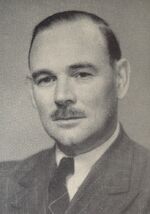
Mexican President Vincent Mercator.
Colonel Vincent Mercator, commander of the Guadalajara garrison, declared martial law in his district in the name of order and to "defend the constitution." Other garrison commanders elsewhere in the U.S.M. followed suit. Mercator and ten other garrison commanders met in secret in Mexico City on the morning of 18 January, after which Mercator announced that Suarez would not be allowed to take office the following day, due to the risk that civil war would break out. Within an hour, Suarez was taken into protective custody, while Silva was arrested for "crimes against the republic." That evening, Mercator announced the creation of a provisional government headed by Marshal Felix Garcia, in which he would serve as Secretary of War.
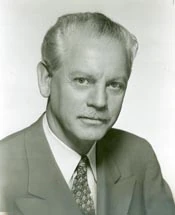
K.A. President Carl Salazar.
Initially, Mercator made no moves to resume hostility with Mexico's foreign enemies. Instead, he concentrated on crushing the guerrilla movements of Armondo Santa Cruz and Miguel Calhoun, and nationalizing the Mexican assets of Kramer Associates. Kramer President Carl Salazar retaliated in late 1953 by ordering all K.A. subsidiaries to halt all trade with the U.S.M., and by increasing K.A.'s oil production until Mexico's oil exports were no longer profitable. This led Mercator to depose Marshal Garcia and name himself President of Mexico, and to declare, "The war is not over. We will never rest until all our enemies are destroyed, and the revolution is completed." Mercator began building up Mexico's armed forces and enlarging the military bases in Hawaii. On 4 January 1955, Mercator gave a speech in which he said that "Mexico's enemies must not go unpunished. We will push in Mr. Salazar's ugly snout, and make him wish he hadn't thought of his slimy plan to destroy us." Sobel declares this the start of the second phase of the War Without War.
Second Phase[]
The Confederation of North America had remained neutral during the war, and it continued that neutrality during the War Without War. In March 1949 Councilman Richard Mason proposed a global reconstruction program that became known as the Mason Doctrine. Mason rode a postwar mood of guilt in the C.N.A. to victory in the 1953 Grand Council elections, becoming Governor-General of the C.N.A., and expanding the Mason Doctrine program.
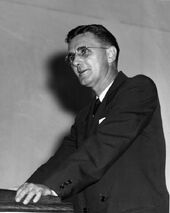
Governor-General Richard Mason.
In the U.S.M., Mercator believed that since Salazar had no armed forces of his own, he would seek an alliance with the C.N.A. Mercator began speaking of a "C.N.A.- Kramer axis" which he described as "a dagger at our hearts." Mason sought a meeting with Mercator in 1958 to assure him that he had nothing to fear from the C.N.A., but Mercator refused. By the summer of 1959, Mexican warships were regularly patrolling the western Pacific, not far from the Philippines, and at one point were within range of shore batteries on Taiwan. At the same time, Mercator fortified Martinique, signed an agreement with Cuba which allowed for Mexican troops to be stationed at Guantanamo Bay, and occupied St. Maarten, which was transformed into a major naval and air base by the end of 1959.
Mercator's military buildup led to alarm among the North American political elite in Burgoyne, and Mason's supporters in the Grand Council began to urge him to increase North American military spending. At the same time, young North Americans with little interest in the debate over the Mason Doctrine were growing increasingly pacifistic, believing that war would not come because "it made no sense." Mason himself came to share this belief, and as he lost support among older North Americans, he gained it among the postwar generation.
Carl Salazar had hoped to make Mercator's imagined Kramer-C.N.A. alliance a reality, but by 1958 he became convinced that Mason would not agree to it. Instead, Salazar initiated the Taichung Project, a secret scientific research project to create an atomic bomb. Four years later, an experimental atomic bomb was detonated in the north Pacific on 30 June 1962. Films of the atomic bomb test were delivered to the governments of the C.N.A., the U.S.M., Germany, and Great Britain on 10 July, and ten days later Salazar held a press conference in Taiwan. He said, "We shall never use this device in the cause of aggrandizement. But we will not hesitate to destroy any nation that has the foolishness to re-open the Global War." Sobel states that this was the beginning of the third phase of the War Without War.
Third Phase[]
The third phase of the War Without War consisted of most of the world's major powers seeking to reproduce K.A.'s atomic weapon. The sole exception was the C.N.A. under Mason, which declined to pursue atomic weapons research.
Mercator evidently had advance word of K.A.'s atomic test, since on 8 July, two days before the major powers received films of the test, he placed the U.S.M. under martial law and ordered Secretary of War Diego Calvares to begin an atomic research project. When it became clear that K.A. would not launch an attack on Mexico, Mercator lifted martial law.
On 20 November 1962 Mercator proclaimed the Offensive of the Dove, calling on the nations of the world to sign a non-aggression pact which would also guarantee the neutrality of those countries which were not involved in the Global War. He also called for a world conference of the belligerents to meet in Geneva in the summer of 1963 to sign treaties ending the war. Finally, Mercator pledged that the U.S.M. would never start a war, and would destroy all offensive weapons after the treaties were signed. During the next two years, 113 nations signed Mercator's non-aggression pact, even though it had no enforcement provisions to prevent the outbreak of war. Meanwhile, both the British and the Germans refused to attend the Geneva Conference, since no agenda had been agreed upon.
In the C.N.A., Mason's refusal to develop atomic weapons led to a convention fight in January 1963 with his Minister for Home Affairs, Grover Speigal. Although Mason won the Liberal Party's nomination for governor-general, he evidently felt he could not count on the Grand Council's Liberal Caucus to support him. He ran a slate of candidates called the Justice Brigades who supported his pacifist agenda, but in the 1963 Grand Council elections none of his candidates won their seats. Councilman Perry Jay of the People's Coalition became the new governor-general, and he immediately established a North American atomic weapons project in Michigan City.
Most of Mexico's scientists had fled the country after the Mercator coup, crippling Secretary Calvares' atomic bomb project. Meanwhile, British scientists carried out a successful bomb test on 14 February 1965, followed by a successful German test on 19 March 1966, and a North American one on 1 September 1966. Mexican spies attempted to bribe foreign scientists and technicians to defect to the U.S.M., and such attempts were uncovered in Germany and Great Britain in 1966 and 1967, and in the C.N.A. in 1969. Sobel states that as of November 1971, the U.S.M. remains the only major nation without the atomic bomb.
Following the exposure of the Mexican spy ring in Michigan City, Governor-General Carter Monaghan broke off diplomatic relations with the U.S.M. and closed the Mexican border. Since then, guerrilla activity has broken out along the border between Jefferson and Southern Vandalia. Sobel states that while this activity is not serious enough to warrant an international conference, it could easily escalate into a major confrontation. If that occurred, the other nations and K.A. would be drawn into a new Global War.
Sources[]
Sobel's sources for the War Without War are Kenneth Zarb's Garcia! (New York, 1965) and Inside the U.S.M.: Mercator's Folly (New York, 1971); James Volk's The Bomb Myth (New York, 1967); Jackson Randolph's The Inner History of the War Without War (New York, 1968); and Max Josephson's The End of the Western Era (New York, 1971).
This was the Featured Article for the week of 17 March 2013.
| C.N.A. Historical Eras |
|---|
| American Crisis • North American Rebellion • Four Viceroys • Britannic Design • Dickinson Era • Trans-Oceanic War • Era of Harmonious Relations • Crisis Years • Rocky Mountain War • Era of Faceless Men • Age of Renewal • Bloody Eighties • Creative Nationalism • Starkist Terror • Years of the Pygmies • Malaise Years • Diffusion Era • Global War • New Day • War Without War |
